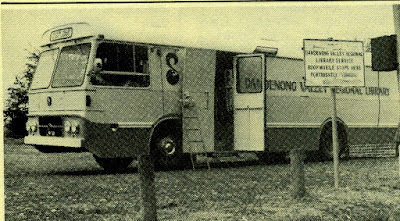Every week the Mobile Library visits 11 different stops in the Cardinia Shire. The area has had a Mobile Library since 1973 and probably the peak of the service was in the late 1970s/early 1980s because as more Library Branches were built the need for mobile libraries lessened. If you are old enough then you would remember mobile libraries being referred to 'the bus library' as that's what it was - a bus full of books.
Library services in this area were provided for many years by the Dandenong Valley Regional Library Service (DVRLS) which commenced on March 9, 1973. This was a co-operative venture and it served the Shires of Pakenham and Cranbourne and the Cities of Berwick, Dandenong and Springvale. In 1973, the DVRLS began its mobile service but the individual Councils soon realised that to gain better coverage of their area they should purchase their own vehicle. Thus in November 1976 the Cranbourne Shire purchased a Library book mobile - the number of stops went from 4 to 15 and the number of loans went from around 16, 500 in 1974 to 85, 500 in 1977* a phenomenal increase which showed that people were interested in Library services.
In 1980/1981 the Berwick Pakenham Mobile visited 24 places per fortnight; the Cranbourne Mobile 15 places per fortnight and the Springvale Mobile 20 places per fortnight. This map, from the 1980/81 DVRLS Annual Report shows the branch Libraries and the bookmobile sites.
This is also from the DVRLS Annual Report 1980/1981 and shows the address of each stop and the circulation figures.
The Cranbourne Shire Mobile timetable in 1984.
In 1987 the City of Berwick ceased Mobile Library Services due to opening of the Endeavour Library in the May. This meant that the municipality now had static branches (as we like to call them) at Doveton, Narre Warren (in Malcolm Court) and Endeavour Hills.
This is the Mobile at Endeavour Hills in 1979.
As early as 1984 there was concern at the age over the age of the Mobiles in Pakenham and Cranbourne, by then they were both over 10 years old and the Annual Report says a decision needs to be made as to whether Pakenham and Cranbourne each plan to buy a new bookmobile or a large vehicle is purchased jointly and shared. As it was it was not until April 1991 that Cranbourne purchased a new articulated vehicle and less than a year later in January 1992 Pakenham also purchased an articulated vehicle - by that we mean a prime mover and a trailer. The new vehicles increased loans - Cranbourne loans went from 43,300 to 54,100 in the first full year of operation and Pakenham Mobile loans increased 50 per cent in the first eight months of operation.
This is the Cranbourne Mobile in 1993
The Cranbourne Mobile service ceased in December 1995, following the Council amalgamations of the previous year and the loss of most of its territory to Frankston City Council. Another consequence of the council reform was the disaggregation of the DVRLS as the newly created City of Greater Dandenong (the old Cities of Dandenong and Springvale) withdrew from the DVRLS in 1995 and so the Casey Cardinia Library Service was created on October 1, 1996, with the newly created City of Casey and Cardinia Shire.
The Cardinia Shire has continued on with the Mobile Library - a new trailer was purchased in 1999 and it was refurbished in April 2010. The opening of the new Emerald Library in July 2006 meant that the mobile no longer had to visit the township, but Maryknoll became a new mobile stop as did a second visit to Bunyip on the Saturday morning. A new prime mover was purchased in June 2013. Incidentally, in spite of the fact that it is a very urbanised and that traditionally Mobiles service rural areas, the City of Greater Dandenong didn't close down its mobile library service until about 2007. If you want an historical view of the townships the Cardinia Mobile stops at click here.
*The Good Country: into the dawn of a new day, 1968 to 1988 by Fred Hooper
*The Good Country: into the dawn of a new day, 1968 to 1988 by Fred Hooper























